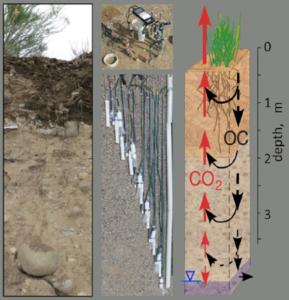In this SFA study (Tokunaga et al., Vadose Zone Journal), vertical profiles of carbon dioxide concentrations in pore gases, measured from the soil surface down to the water table in a semi-arid floodplain, were shown to have significant contributions from microbial respiration in the deeper vadose zone, well below the rooting depth and above the water table. Approximately 17% of the surface CO2 flux originates from depths between 2.0 and 3.5 meters. Respiration in the vadose zone and low net infiltration limit organic carbon transport to the aquifer. These contributions are not typically accounted for in Earth System Models (ESMs).
Summary
Although CO2 fluxes from soils are often assumed to originate within shallow soil horizons (< 1 m depth), relatively little is known about respiration rates at greater depths. The authors compared measured and calculated CO2 fluxes at the Rifle floodplain along the Colorado River, and measured CO2 production rates of floodplain sediments in order to determine the relative importance of vadose zone respiration. Calculations based on measured CO2 gradients and estimated effective diffusion coefficients yielded fluxes that are generally consistent with measurements obtained at the soil surface (326 g C m-2 yr-1). CO2 production from the 2.0 to 3.5 m depth interval was calculated to contribute 17% of the total floodplain respiration, with rates that were larger than some parts of the shallower vadose zone and underlying aquifer. Microbial respiration rates determined from laboratory incubation tests of the sediments support this conclusion. The deeper unsaturated zone typically maintains intermediate water and air saturations, lacks extreme temperatures and salinities, and is annually resupplied with organic carbon from snowmelt-driven recharge and by water table decline. This combination of favorable conditions supports deeper unsaturated zone microbial respiration throughout the year.

